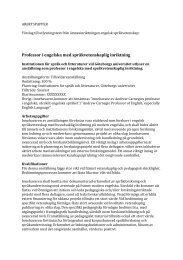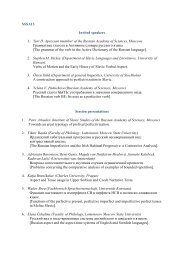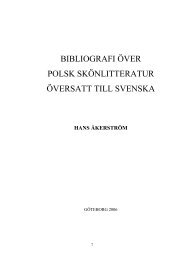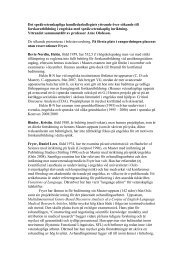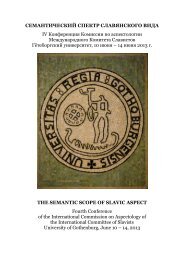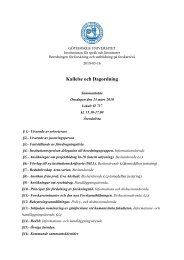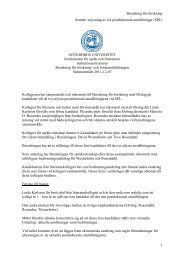liest known written clues regarding ancient musical practices. In the lyrics of this song, datedto 1200 BC and found inscribed in cuneiform symbols on a clay tablet, an Assyrian woman approachesthe moon goddess, Nikkal, to seek a cure for infertility. 14 However, there is even earlierevidence of musical activity than these examples, including primitive Stone Age cave paintingsand, most recently, the discovery of bone flutes from over 35,000 years ago in the region that isnow southwestern Germany. 15 Music clearly serves an essential human need, as seen from its usein all known societies to construct meaning and regulate social behavior, as well as evidence ofits practice that extends to prehistoric times, and it may very well have evolved in tandem withlanguage.THEORETICAL MODEL OF MUSIC TRANSLATIONThe theoretical model I will propose in this essay has two parts: a) Four <strong>Cultural</strong>ist Conceptions,and b) Five Domains of <strong>Cultural</strong> Translation via Music. The first part illustrates how crossculturalrelationships may be conceived in relation to education and other institutionalizedforms of socially structured interaction, which also has implications for literature and relatedarts. Rather than serving an analytical function for interpretation of particular examples of crossculturalartistry, the Four <strong>Cultural</strong>ist Conceptions is intended to serve an illustrative purpose innormative discussion of prospective approaches to cultural policy. The second part Five Domainsof <strong>Cultural</strong> Translation via Music delineates diverse aspects of music production and consumptionthat may parallel phenomena encountered in other art forms, and as will be demonstrated,is proposed for direct use as an analytical tool.If multicultural education, as James Banks explains in Routledge International Companionto Multicultural Education, is “a concept, an educational reform movement, and a process” that“incorporates the idea that all students – regardless of their ethnic, racial, cultural, or linguisticcharacteristics – should have an equal opportunity to learn in school,” 16 then there would seem tobe precious little philosophical - especially ethical - foundation for opposition to multiculturalistapproaches to education in the 21 st century. Still, the notion of multiculturalism continues to bedebated – particularly in contemporary Europe – and the field of cultural translation seems increasinglyconcerned with this issue. When considered from an historical perspective, it becomesclear that this way of thinking about education has only become popular in recent generations.Moreover, nowadays, as I have written elsewhere, “the dizzying array of complex inequalitiesand diverse identities encountered across the globe today may even justify adopting the perspectivethat any education which is not to some extent multicultural in orientation essentially failsto offer students sufficient opportunities to become meaningfully attuned to the reality of thehuman condition outside their immediate experience.” 17 Music today, despite the commodifica-14 This is according to Dr. Theo J. H. Krispijn, Professor of Assyriology at Leiden University, the Netherlands.See Charles Leroux, “Blast from the past: The tale of the oldest song ever,” Chicago Tribune (2007,April 2).15 Nicholas J. Conard, Maria Malina, and Susanne C. Münzel, “New flutes document the earliest musical traditionin southwestern Germany,” Nature, 460 (August 2009), 737–40.16 James A. Banks, ed., Routledge International Handbook of Multicultural Education (London: Routledge,2009) p.1.17 David G. Hebert and Sidsel Karlsen, “Editorial introduction: Multiculturalism and music education” FinnishJournal of Music Education, 13(1), 6-11 (2010), p.7.<strong>Cultural</strong> translation and Music25
tion and disjuncture from origins caused by its dissemination via mass media, remains stronglyconnected to cultural roots, even among hybrid genres, a phenomenon that has complex andmultifaceted educational implications. 18 The following coloured figure illustrates Four <strong>Cultural</strong>istConceptions, as will be explained further below:Model 1. Four <strong>Cultural</strong>ist ConceptionsFigure 1: Model-Four <strong>Cultural</strong>ist Conceptions26Figure 1: Model-Four <strong>Cultural</strong>ist ConceptionsThe Four <strong>Cultural</strong>ist Conceptions illustrated here consist of 1) Biculturalism, 2) Multiculturalism,3) Interculturalism, and 4) Transculturalism. Each conception entails a slightly differentapproach to institutionalization of the cross-cultural meeting of two or more distinct traditions,as encountered in various public sector contexts, such as education and arts policy. The firstThe Four <strong>Cultural</strong>ist Conceptions illustrated here consist of 1) Biculturalism, 2)example, “Biculturalism”, indicates the meeting of two major cultural strands, each of which isMulticulturalism, expected to respond to 3) the Interculturalism, other in an attitude of cooperation and 4) Transculturalism. and even compromise. This Each ap-conception enslightly different approach to institutionalization of the cross-cultural meeting of tproach to cross-cultural contact has for many years been regarded as official government policymore in such distinct nations as traditions, New Zealand, as where encountered there is a single in clearly various identifiable public indigenous sector popula-contexts, such aseducation and a single and colonizing arts policy. power, The in this first case the example, Maori and “Biculturalism”, British (or Pakeha) residents. indicates the meetinHowever, as I have discussed elsewhere, 19 nowadays the demographic makeup of even a nationtwo major cultural strands, each of which is expected to respond to the other in anlike New Zealand is actually far more complex than mere biculturalism would appear to suggest,attitude of cooperation and even compromise. This approach to cross-cultural confor 18 many David G. years Hebert, Jazz been and Rock regarded Music, W. as M. Anderson official and government P. S. Campbell, eds., policy Multicultural in such Perspectivesin Music where Education, there vol.1 is (Lanham: a single Rowman-Littlefield, clearly identifiable 2010); David G. Hebert, indigenous Ethnicity and population Music and a snations as NeZealand,Education: Sociological Dimensions, R. Wright, ed., Sociology and Music Education (Aldershot: Ashgate,colonizing 2010), pp.93-114; power, David G. in Hebert, this Rethinking case the Historiography Maori and of Hybrid British Genres (or in Music Pakeha) Education, residents. L. HowevVakeva and V. Kurkela, eds., De-Canonizing Music History (Newcastle: Cambridge Scholars Press, 2009),have discussed elsewhere, 19 nowadays the demographic makeup of even a nationpp.163-184.New 19 David Zealand G. Hebert, is “Music actually transmission far more in an Auckland complex Tongan than community mere youth biculturalism band,” International would appearJournal of Community Music, 1(2), (2008) pp.169-188.suggest, since there are many Asians and Pacific Islander residents from an arraybackgrounds, some of whom (such as in the case of the Niueans) are found in greaDavid G. Hebertnumbers in New Zealand than “back home.” The second example, Multiculturalisoften represented through the use of such common metaphors as a “melting pot” o
- Page 1: Cultural TranslationsProceedings of
- Page 4 and 5: PrefaceThe idea of organizing a wor
- Page 6 and 7: ContentsAcknowledgementIIPrefaceIII
- Page 8 and 9: Literature and Transculturality:Som
- Page 10 and 11: agenda of Herder, which was to figh
- Page 12 and 13: nomenon. However, until long into t
- Page 14 and 15: Tawada’s work appeared in Swedish
- Page 16 and 17: multiple interpretations. Japan is
- Page 18 and 19: Cultural Translation between Tradit
- Page 20 and 21: George P. Murdock illustrated the p
- Page 22 and 23: ancestor of the Maori arrived in Ao
- Page 24 and 25: nal names do not necessarily have.
- Page 26 and 27: One of the functions of ‘cultural
- Page 28 and 29: PRELUDEIn 2003, an original artisti
- Page 30 and 31: planted, adopted and fused with ind
- Page 34 and 35: since there are many Asians and Pac
- Page 36 and 37: listening to and evaluating sounds
- Page 38 and 39: Ensemble, and the Moscow Pan-Asian
- Page 40 and 41: temporary Finnish folk music. 29I a
- Page 42 and 43: Although some space for improvisati
- Page 44 and 45: whom have devoted many years to ser
- Page 46: POSTLUDEBy way of conclusion, allow
- Page 49 and 50: IntroductionThe aim of this paper i
- Page 51 and 52: to discuss what role Japan was to p
- Page 53 and 54: I may be allowed henceforth to use
- Page 55 and 56: program was to promote and help stu
- Page 57 and 58: 50different of that of Millán -Ast
- Page 59 and 60: most impracticable people in the ea
- Page 61 and 62: intending to give the Book a quasi
- Page 63 and 64: understood by the West on a time wh
- Page 65 and 66: FUJIWARA Masahiko. (2008) Kokka no
- Page 67: - (2002) Cultural light, political
- Page 70 and 71: Translation, or better, linguistic
- Page 72 and 73: one may not expect anything other t
- Page 74 and 75: as Murakami opts for a globalized v
- Page 76 and 77: market. 17 Another indispensable to
- Page 78 and 79: (This is part of my doctoral thesis
- Page 80 and 81: elieve advances man’s progress he
- Page 82 and 83:
ender the New Testament into Japane
- Page 84 and 85:
a synonym for kami. The latter is a
- Page 86 and 87:
The American school text is in the
- Page 88 and 89:
Willson Reader 46 T73 47I will not
- Page 90 and 91:
Gentlzer, Edwin & Tymoczko, Maria 2
- Page 92 and 93:
Tea ceremony or tea cult?Translatin
- Page 94 and 95:
Company (VOC), men came from differ
- Page 96 and 97:
H. Stolpe gathered items in Japan f
- Page 98 and 99:
simple presentations had negative i
- Page 100 and 101:
theticism, with its manifold bearin
- Page 102 and 103:
Kumakura, Isao (1980) 近 代 茶
- Page 104 and 105:
1. Introduction and aim of the pape
- Page 106 and 107:
main character and the caller doesn
- Page 108 and 109:
not” and ”at present” that ha
- Page 110 and 111:
match this name, a sea as artificia
- Page 112 and 113:
I John Gabriel BorkmanHenrik Ibsen
- Page 114 and 115:
his dream during the 1870s, when ca
- Page 116 and 117:
make a decision. But it turns out t
- Page 118 and 119:
Ôgai’s change of translation str
- Page 120 and 121:
Behind every utterance lies two mot
- Page 122 and 123:
a large group of persons be gathere
- Page 124 and 125:
The “Territory of Translation”
- Page 126 and 127:
八 十 日 間 世 界 一 周 :
- Page 128 and 129:
heuristic tools, especially conside
- Page 130 and 131:
Left: Photo of Kawashima Chūnosuke
- Page 132 and 133:
Burlington Gardens is in London (Ro
- Page 134 and 135:
門 アリ 入 リテ 見 レバ
- Page 136 and 137:
scene seems to be merely one of man
- Page 138 and 139:
Niwa Jun’ichirō’s Spring Tale
- Page 140 and 141:
The text is full of detailed descri
- Page 142 and 143:
where the narrative voice does not
- Page 144 and 145:
The reason the “territory of tran
- Page 146 and 147:
Translating the Trip Around the Wor
- Page 148 and 149:
ForwordI have been working on my do
- Page 150 and 151:
clining though. By the end of 1980
- Page 152 and 153:
幸 い 神 の 怒 りは 鎮 ま
- Page 154 and 155:
The Public Sphere as Deliberation o
- Page 156 and 157:
and absence of hierarchy would have
- Page 158 and 159:
was used much like we would use “
- Page 160 and 161:
outcasts and bandits - were suppose
- Page 162 and 163:
cal sense, the arena where particip
- Page 164 and 165:
society” and in which “there wa
- Page 166 and 167:
sic formulations, the public sphere
- Page 168 and 169:
はじめに日 本 統 治 下 の
- Page 170 and 171:
似 地 一 下 一 下 拽 那 鼻
- Page 172 and 173:
ということから、 古 丁
- Page 174 and 175:
の「 序 」で、 大 東 亜
- Page 176 and 177:
3.1 翻 訳 と 満 洲 国 語 政
- Page 178 and 179:
取 り 入 れを 主 張 する
- Page 180 and 181:
文 化 の 翻 訳 としての「
- Page 182 and 183:
史 性 にも 留 意 すべきだ
- Page 184 and 185:
て、 渦 巻 きよりほかは
- Page 186 and 187:
変 わらないということも
- Page 188 and 189:
訳 語 と 新 語 から 見 る
- Page 190 and 191:
しは「 無 為 」や「 本 性
- Page 192 and 193:
思 想 を 基 礎 として、
- Page 194 and 195:
って「 物 理 上 哲 学 」
- Page 196 and 197:
し、まさにはこの 時 期
- Page 198 and 199:
意 譯 : 理 學 、 性傅 汛
- Page 200 and 201:
柴 田 昌『 增 補 訂 正 英
- Page 202 and 203:
一 八 七 七 年 、 文 部 省
- Page 204 and 205:
日 中 友 好 の 象 徴 「 鑑
- Page 206 and 207:
と 指 摘 した。成 吉 思
- Page 208 and 209:
をあげている。さらにま
- Page 210 and 211:
に 請 ひて 出 家 を 求 む
- Page 212 and 213:
この 時 奉 請 の 十 師 等
- Page 214 and 215:
歴 史 小 説 『 天 平 の 甍
- Page 216 and 217:
点 」が 生 じたと 指 摘
- Page 218 and 219:
まず、 昨 今 、 活 発 に
- Page 220 and 221:
2、 従 来 の 比 較 文 学 (c
- Page 222 and 223:
普 遍 理 論 を 適 用 し、
- Page 224 and 225:
ス・テグネル(Esaias Tegnér,
- Page 226 and 227:
に 満 ちる「 生 命 」に
- Page 228 and 229:
う 形 をとって 展 開 した
- Page 230:
学 が 大 学 で 展 開 して



